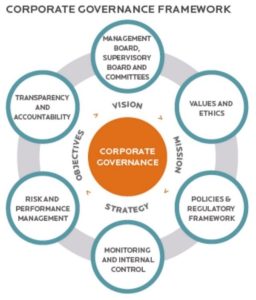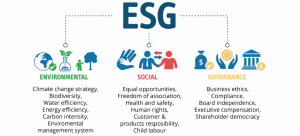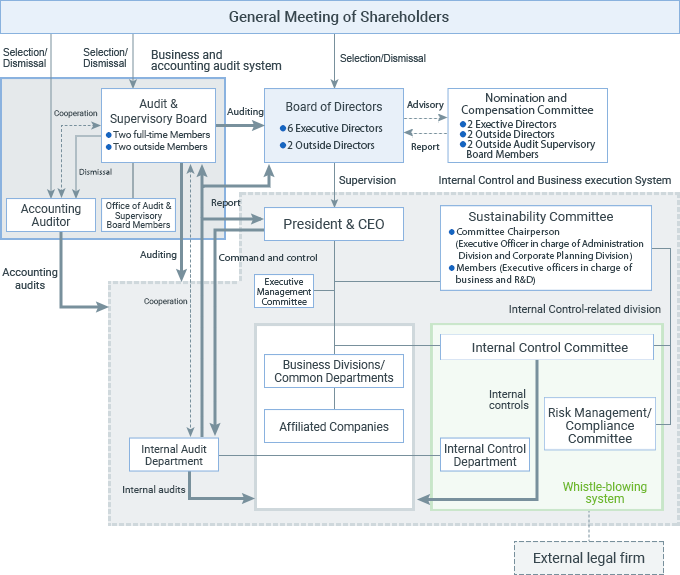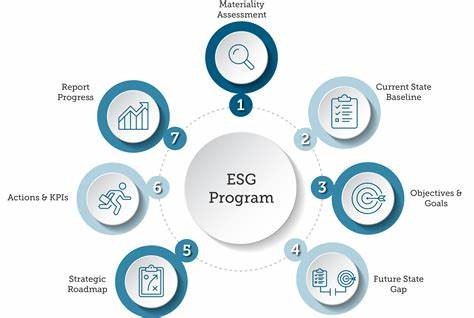Introduction
Corporate governance and ESG (Environmental, Social, and
Governance) are two closely related concepts. Corporate governance refers to
the system of rules, practices, and processes by which a company is directed
and controlled. It encompasses the relationships between a company's
management, its board of directors, shareholders, and other stakeholders, and
the goals for which the corporation is governed. Good corporate governance is
important for ensuring that a company is managed in an ethical, transparent,
and effective manner and that it maximizes value for all stakeholders over the
long term.
Corporate Governance Framework
ESG, on the other hand, refers to the three key factors
that are used to measure the sustainability and ethical impact of an investment
in a company: Environmental, Social, and Governance. Environmental factors
include a company's impact on the environment, such as its carbon footprint and
resource use. Social factors include a company's impact on society, such as its
treatment of employees, customers, and suppliers. Governance factors include a
company's management structure, executive compensation, and board composition.

ESG is becoming an increasingly important consideration
for investors and stakeholders, as they seek to invest in companies that are
aligned with their values and have a positive impact on the world. Good
corporate governance is a key component of ESG, as it ensures that a company is
managed responsibly and sustainably, and that it is held accountable for its
environmental and social impact. Companies that prioritize ESG factors are more
likely to attract and retain investors, customers, and employees and are better
positioned to create long-term value for all stakeholders.

Contemporary Corporate Governance
Corporate governance is evolving to take into account
changing business models, technological advancements, and stakeholder
expectations. Here are some key trends in corporate governance:
1. Emphasis on sustainability: Companies are
increasingly expected to integrate ESG considerations into their
decision-making processes and to report on their sustainability efforts. This
requires a shift in focus from short-term profits to long-term value creation.
2. Board diversity: There is a growing recognition
of the importance of board diversity in ensuring effective corporate
governance. Companies are expected to have boards that reflect the diversity of
their stakeholders and that bring a range of perspectives and skills to the
table.
3. Increased stakeholder engagement: Companies are
expected to engage with a wider range of stakeholders, including employees,
customers, suppliers, and communities. This requires a more inclusive and
collaborative approach to decision-making.
4. Technology and innovation: Technology is
transforming the way companies operate, and corporate governance needs to
evolve to keep pace. Boards need to have the skills and expertise to understand
and oversee technological risks and opportunities.
5. Transparency and accountability: There is a growing
expectation for companies to be transparent about their governance practices,
including executive compensation, board composition, and decision-making
processes. Companies are also expected to be accountable for their actions and
to have effective systems in place for managing risk.
Overall, corporate governance in the new era is focused on
creating long-term value for all stakeholders, rather than just maximizing
short-term profits. It requires a more inclusive, collaborative, and
transparent approach to decision-making, and a willingness to adapt to changing
circumstances and stakeholder expectations. These points bring sustainability
to the forefront, but from the perspective of stakeholders. It is increasingly
becoming impossible to focus on shareholders only and it is not sustainable.
This is where the concept of ESG is taking centre stage and the present boards
must have this on their agenda.

Corporate Governance System incorporating ESG
The
Nexus Between Profits and Principles
Corporate Governance and ESG represent what Johnson
Lambert referred to as ‘the intersection between profits and principles”. The
awareness in the recent past on the ESG issues has driven companies to review
their system of values and ensure that they reflect evolving stakeholder
priorities, especially on climate change and social justice. ESG reflects a
shift in how companies evaluate the risks that could impact their organisation
and how they are evaluated by their stakeholders on how they respond to environmental
and social issues.
Companies that proactively embrace ESG may be better
positioned in the market. While ESG is deemed a cost, it is increasingly
becoming a profit too. Investors and business partners are increasingly seeking
to work with (and may be willing to pay a premium for) companies that
demonstrate a commitment to ESG issues from an operational perspective. A
company may also position itself as a preferred employer, especially for the
new generation of employees who prefer to work with companies with values,
putting the environment and social issues forefront. Regulation and rating
agencies have also emphasized corporate responsibility and ESG from a risk and
governance perspective.
Whereas ESG can bring a competitive advantage amongst diverse
stakeholders, it is centered on the quality of leadership. It requires support
and accountability from the top leadership and those charged with governance as
a prerequisite for success. They need to develop a strategy to deliver on ESG
programs.
7 steps to develop and implement ESG
Strategy

The starting point for ESG is assessing materiality, then
baseline – knowing where the organisation is regarding key ESG metrics. It
requires an honest assessment of the ESG landscape in the organisation. The big
question will then be: Where does the board want the company to be and what
incremental steps should it take? This future-state response will result in
short- and long-term goals with key accountability checkpoints along the way.
The board will set the strategic objectives, incorporating these, but the
management will provide a tactical role, taking short-term incremental steps to
take the organisation to where it needs to be, as they remain accountable to
the board.
The board culture and composition have a key bearing on
the success of the sustainability journey. A diverse board improves the
dynamics of the organization by offering different perspectives, which may make
problem-solving easier and can generate innovative ideas and solutions. To maintain
an independent and engaged board, best practice includes having clearly defined
roles and expectations of board members. Members need to be evaluated for
conflict of interest and the board chair needs to be rotated regularly.
Regarding ESG, board members may consider asking the right
questions to make an impact on the ESG strategy. What are we doing to be a good
company and how are we getting better? What are you doing to take care of the environment,
our customers and other stakeholders? How does ESG fit into our organisational
structure? By viewing ESG as a strategic objective, leaders can build a common
language around the company’s values and understanding of what the company
wants to achieve and how each person fits into the larger picture.
When a company and its board are committed to ESG, they
are upholding their responsibility to evolving stakeholder priorities. Leading
by example helps to maintain a good reputation and can increase long-term
profitability and brand loyalty.
However, challenges can and should be expected along the way. The
differentiating factor that will impact an organization’s success and growth is
the organization’s response. In a workplace, there may be four different
generations with very different values working on the same team. Remaining
transparent and setting clear expectations, as well as checking in through
every step, may help ease employees through any transitions.
It can also be difficult to carve out time to focus on
priorities that may not immediately impact the bottom line and could cost money
up front, that are for the greater good of the company, the environment and the
community. However, every little bit counts, and measuring and tracking your
progress is a must. Organizational change can be measured and shared
quantitatively through financial reports, ratios, and ratings. It can be
measured qualitatively through engagement via surveys and town hall meetings.
When employees feel heard, they are more satisfied with their work. When they
and other stakeholders understand the values of the company, they are more
likely to get behind them.
No matter how big or small your goals are when it comes to
ESG, a thorough self-assessment is always the first step. Once that is
complete, it’s important to consider the state of your current board, set goals
for the organization, explore areas of opportunity and maintain transparency
every step of the way. Though it may be challenging, a company with an ESG
strategy that reflects modern times reassures shareholders, invites coveted
talent, and upholds social responsibility for the betterment of everyone.
